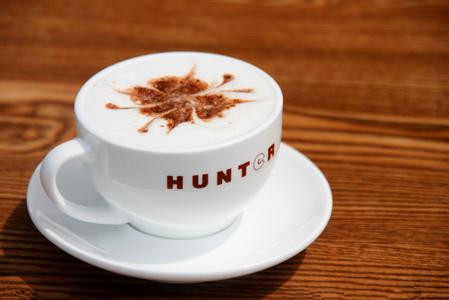Hometown of fragrant Blue Mountain Coffee, Jamaican Coffee Blue Mountain Coffee
I have heard that Jamaica's Blue Mountain Coffee is famous all over the world and has been longing for it for a long time. Not long ago, I took the opportunity of an interview with this Caribbean island country to specially appreciate the strong and honest aroma of Blue Mountain Coffee and put an end to a long-cherished wish in my heart.

Take a bus from Kingston and follow the winding mountain road to Strawberry Villa, a famous scenic spot in the Blue Mountains. Enjoying the mountain scenery in front of me and the sea view in the distance, it is very pleasant to have a cup of authentic Blue Mountain coffee. Blue Mountain Coffee has a mellow taste, moderate acidity, sweetness and bitterness, and has an attractive elegance, which is really different from other varieties of coffee.
The area of Jamaica is small, northeast of the capital Kingston is the Blue Mountains. Most of the peaks of the Blue Mountains are more than 1800 meters above sea level, and the famous Blue Mountain Coffee grows in this mountain area. It is reported that Jamaican coffee was introduced by a French naval officer from a nearby area in 1723, but the cultivation of this crop did not attract enough attention at first. Blue Mountain Coffee came to prominence in 1932 when the Jamaican authorities adopted an important decision to encourage coffee cultivation to reduce dependence on sugar exports.
The unique flavor of Blue Mountain Coffee is related to its geographical location and climatic conditions. Generally speaking, south of the Tropic of Cancer and north of the Tropic of Cancer, this area is suitable for growing coffee, called the "coffee belt". Jamaica is just south of the Tropic of Cancer. The blue mountain is steep, the air is fresh, there is no pollution, it rains all the year round, and there is a great temperature difference between day and night, which has a unique and fertile new volcanic soil. Most importantly, every afternoon, clouds cover the whole mountain area, which not only shades the coffee trees naturally, but also brings abundant water vapor. Because of its superior geographical and climatic conditions, Blue Mountain Coffee is superior to others in taste and aroma.
Coffee beans
In addition to outstanding natural conditions, Blue Mountain Coffee from planting, picking, to cleaning, shelling, roasting and so on, each process is very exquisite, with strict standards. For example, there are explicit rules on the use of organic fertilizers in which growing period, and many of the picking and follow-up procedures are done by hand, and most of the participants are female workers. In order to ensure the quality of coffee during transportation, Jamaica is the last country that still uses traditional wooden barrels to transport coffee.
At a Blue Mountain coffee processing plant for tourists, the commentator revealed to reporters the "secret" of why Blue Mountain coffee tastes pure: their coffee trees are all on rugged hillsides, and the picking process is very difficult. Non-local skilled female workers are simply incompetent. It is very important to choose the right ripe coffee beans when picking. Immaturity or ripeness will affect the quality of the coffee. The picked coffee beans are shelled on the same day, and then let them ferment for 18 hours. After that, the coffee beans were cleaned and screened. The subsequent process is to dry, which must be carried out on the cement floor or on a thick blanket until the humidity of the coffee beans drops to 12% 14%. And then store it in a special warehouse. Take it out and roast when needed, then grind it into powder. These procedures must be strictly mastered, otherwise, the quality of coffee will be affected.
Blue Mountain Coffee can maintain its top status today, which is also related to the local government's policy of limiting production and ensuring quality. Jamaica is not famous for Blue Mountain Coffee, regardless of the quality of mass production. But to give priority to quality, would rather sacrifice output, but also to protect the blue mountain coffee this gold-lettered signboard. Brazil, the world's largest coffee producer, produces 30 million bags (60 kg each) of coffee a year, while Jamaica produces just over 40, 000 bags a year. This shows the difference in output.
All kinds of coffee drinks
Blue Mountain coffee beans are divided into several kinds according to their quality. the top blue mountain coffee beans generally do not enter the circulation market, and most of them are booked by the royal family and tycoons. The Blue Mountain coffee beans on the market are "Blue Mountain" beans guaranteed by the Jamaican government. Statistics from the Coffee International website show that in 2003-2004, Jamaica produced 43000 bags of coffee, of which 24000 bags were exported. Nearly 90 per cent of exports go to Japan and the rest to Europe and the US. Because the output is limited and the export volume is not large, Blue Mountain coffee has been in short supply in the international market. As the saying goes, blue mountain coffee is expensive even in its place of origin, with a 4-ounce (114-gram) bag of blue mountain coffee selling for nearly $7 on the Jamaican market.
In recent years, all kinds of coffee shops in China have sprung up like bamboo shoots after a spring rain, and top Blue Mountain coffee has naturally become the target pursued by people, especially young people. For a moment, it seems that only after tasting Blue Mountain Coffee can you really drink coffee. And if you don't sell Blue Mountain Coffee, it's not a real coffee shop. The price of each cup of "Blue Mountain Coffee" in China ranges from more than 30 yuan to more than 100 yuan, which is really expensive. Of course, if it is the real thing, the above price is also in line with the valuable status of Blue Mountain Coffee.
However, the output and export volume of Jamaican Blue Mountain Coffee is limited, China does not import Blue Mountain Coffee directly from Jamaica, and the International Coffee Organization has no record of exporting Blue Mountain coffee beans to China. In addition, it is believed that most domestic coffee lovers do not have the ability to distinguish between different quality coffee. So remind people to beware: although you pay a high price, the coffee in your cup is probably not the real Blue Mountain coffee.
Important Notice :
前街咖啡 FrontStreet Coffee has moved to new addredd:
FrontStreet Coffee Address: 315,Donghua East Road,GuangZhou
Tel:020 38364473
- Prev

A technical term for tasting coffee and drinking coffee.
Flavor [flavor] is the overall impression of aroma, acidity, and mellowness, which can be used to describe the overall feeling of contrast coffee. Acidity [acidity] is the acidity and strong quality of all coffee grown on the plateau. The acidity referred to here is different from bitterness or sour (sour) and has nothing to do with pH, but promotes coffee to exert its functions of invigorating the mind and clearing the taste.
- Next

Coffee common sense what is the difference between organic coffee and traditional coffee
Coffee factories have traditionally been accompanied by shade trees and other food and commodity crops. This approach is done for healthier soil and prevented water pollution. Unfortunately, many coffee growers have abandoned this approach in favor of larger crops and greater profits. However, integrated pesticides, herbicides and fertilizers have become necessary to maintain these crops and make coffee with them.
Related
- Beginners will see the "Coffee pull flower" guide!
- What is the difference between ice blog purified milk and ordinary milk coffee?
- Why is the Philippines the largest producer of crops in Liberia?
- For coffee extraction, should the fine powder be retained?
- How does extracted espresso fill pressed powder? How much strength does it take to press the powder?
- How to make jasmine cold extract coffee? Is the jasmine + latte good?
- Will this little toy really make the coffee taste better? How does Lily Drip affect coffee extraction?
- Will the action of slapping the filter cup also affect coffee extraction?
- What's the difference between powder-to-water ratio and powder-to-liquid ratio?
- What is the Ethiopian local species? What does it have to do with Heirloom native species?

